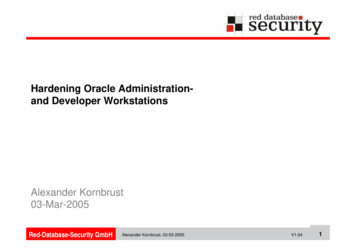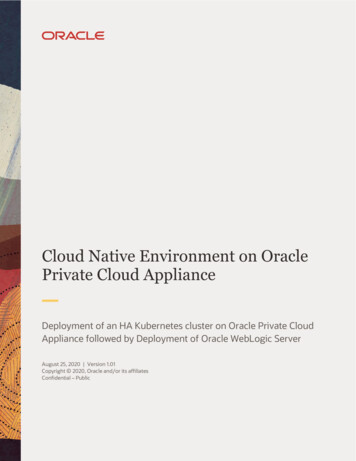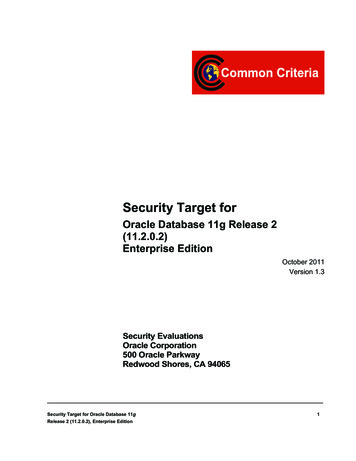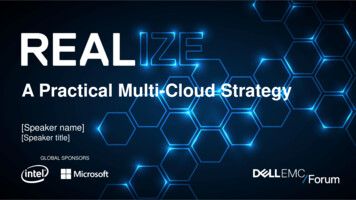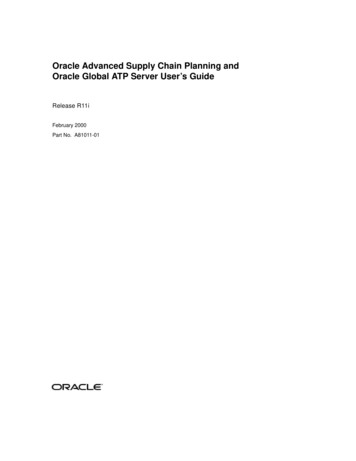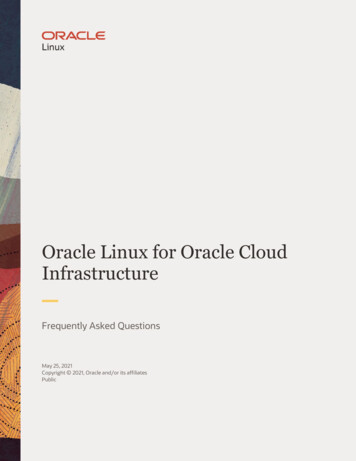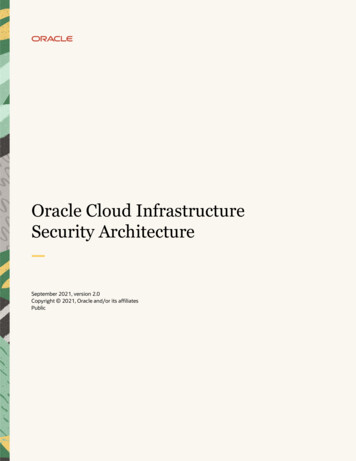
Transcription
Business / Technical BriefOracle Cloud InfrastructureSecurity ArchitectureSeptember 2021, version 2.0Copyright 2021, Oracle and/or its affiliatesPublic1Oracle Cloud Infrastructure Security Architecture / version 2.0Copyright 2021, Oracle and/or its affiliates / Public
Purpose StatementThis document provides an overview of features and enhancements included Oracle Cloud Infrastructure (OCI). It’sintended solely to help you assess the business benefits of OCI and to plan your IT projects.DisclaimerThis document in any form, software or printed matter, contains proprietary information that is the exclusive propertyof Oracle. Your access to and use of this confidential material is subject to the terms and conditions of your Oraclesoftware license and service agreement, which has been executed and with which you agree to comply. Thisdocument and information contained herein may not be disclosed, copied, reproduced or distributed to anyoneoutside Oracle without prior written consent of Oracle. This document is not part of your license agreement nor can itbe incorporated into any contractual agreement with Oracle or its subsidiaries or affiliates.This document is for informational purposes only and is intended solely to assist you in planning for theimplementation and upgrade of the product features described. It is not a commitment to deliver any material, code,or functionality, and should not be relied upon in making purchasing decisions. The development, release, and timingof any features or functionality described in this document remains at the sole discretion of Oracle. Due to the natureof the product architecture, it may not be possible to safely include all features described in this document withoutrisking significant destabilization of the code.Revision HistoryThe following revisions have been made to this document.2DATEREVISIONSeptember 2021Added information about Dedicated Region Cloud@CustomerMarch 2020Initial publicationOracle Cloud Infrastructure Security Architecture / version 2.0Copyright 2021, Oracle and/or its affiliates / Public
Table of ContentsOverview4Security-First Design4First-Generation Public Clouds4Oracle Cloud Infrastructure—Next-Generation Public Cloud4Platform Security4Isolated Network Virtualization5Hardware5Physical Network6Network Segmentation7Fault-Tolerant Infrastructure8Physical Security8Secure Connectivity9Least-Privilege Access9Multiple Authentication Layers9Internal Connectivity9External Connectivity10Dedicated Region Cloud@Customer10Operational Security10Defensive Security10Offensive Security11Security Assurance11Data and Application Protection11Data Access11Data Destruction11Data Encryption12API Security12Culture of Trust and Compliance12Development Security12Personnel Security13Supply-Chain nces143Oracle Cloud Infrastructure Security Architecture / version 2.0Copyright 2021, Oracle and/or its affiliates / Public
OverviewOracle Cloud Infrastructure (OCI) is a next-generation infrastructure-as-a-service (IaaS) offering architected onsecurity-first design principles. These principles include isolated network virtualization and pristine physical hostdeployment, which were previously difficult to achieve with earlier public cloud designs. With these design principles,OCI helps to reduce risk from advanced persistent threats.OCI benefits from tiered defenses and highly secure operations that span from the physical hardware in our datacenters to the web layer, in addition to the protections and controls available in our cloud. Many of these protectionsalso work with third-party clouds and on-premises solutions to help secure modern enterprise workloads and datawhere they reside.This document describes how OCI addresses the security requirements of customers who run critical and sensitiveworkloads. It details how security is fundamental to the architecture, data-center design, personnel selection, andprocesses for provisioning, using, certifying, and maintaining OCI.Security-First DesignAs cloud has become more common, security concerns have become more important. From its inception, OracleCloud Infrastructure prioritized solving the security issues that grew out of first-generation clouds.First-Generation Public CloudsFirst-generation public clouds focused on the efficient use of hardware resources enabled by virtualization and use ofa hypervisor. These clouds were built on many of the same technologies and principles used in private clouds, whichwere designed so that expensive hardware resources didn’t remain idle. Security sometimes wasn’t a foundationalprinciple of this design because private data centers relied on perimeter defenses. As public cloud use became morecommon, so did concerns about attacks associated with hypervisor vulnerabilities. Security is a primary concern forenterprise customers, and the risk associated with the hypervisor design of first-generation public clouds was onlygrowing.Oracle Cloud Infrastructure—Next-Generation Public CloudOCI is a security-first public cloud infrastructure that Oracle built for enterprise critical workloads. Security-first meansthat Oracle redesigned the virtualization stack to reduce the risk from hypervisor-based attacks and increase tenantisolation. The result is a next-generation public cloud infrastructure design that provides significant security benefitsover first-generation cloud infrastructure designs. We’ve implemented this design in every data center and region.OCI is a complete IaaS platform. It provides the services needed to build and run applications in a highly secure,hosted environment with high performance and availability. Customers can run the Compute and Database serviceson bare metal instances, which are customer-dedicated physical servers, or as virtual machines (VM) instances, whichare isolated computing environments on top of bare metal hardware. Bare metal and VM instances run on the sametypes of server hardware, firmware, underlying software, and networking infrastructure, so both instance types havethe OCI protections built into those layers.Platform SecurityOracle designed Oracle Cloud Infrastructure architecture for security of the platform through isolated networkvirtualization, highly secure firmware installation, a controlled physical network, and network segmentation.4Oracle Cloud Infrastructure Security Architecture / version 2.0Copyright 2021, Oracle and/or its affiliates / Public
Isolated Network VirtualizationCentral to the OCI design is isolated network virtualization, which greatly reduces the risk from the hypervisor.The hypervisor is the software that manages virtual devices in a cloud environment, handling server and networkvirtualization. In traditional virtualization environments, the hypervisor manages network traffic, enabling traffic toflow between VM instances and between VM instances and physical hosts. This adds considerable complexity andcomputational overhead in the hypervisor. Proof-of-concept computer security attacks, such as VM escape attacks,have highlighted the substantial risk that can come with this design. These attacks exploit hypervisor complexity byenabling an attacker to “break out” of a VM instance, access the underlying operating system, and gain control of thehypervisor. The attacker can then potentially access other hosts, sometimes undetected.OCI reduces this risk by decoupling network virtualization from the hypervisor. Oracle has implemented networkvirtualization as a highly customized hardware and software layer that moves cloud control away from the hypervisorand host and puts it on its own network. This hardened and monitored layer of control is what enables isolatednetwork virtualization.Isolated network virtualization reduces risk by limiting the attack surface. Even if a malicious actor succeeds with a VMescape attack on a single host, they can’t reach other hosts in the cloud infrastructure. The attack is containedeffectively to the one host. Oracle has implemented isolated network virtualization in every data center in everyregion, which means that all OCI tenants benefit from this design.Figure 1: Isolated Network Virtualization Reduces Risk in the Oracle Next-Generation CloudHardwareA primary design principle of OCI is protecting tenants from firmware-based attacks. Threats at the firmware level arebecoming more common, which raises the potential risks for public cloud providers. To ensure that each server isprovisioned with clean firmware, Oracle has implemented a hardware-based root of trust for the process of wipingand reinstalling server firmware. Oracle uses this process every time a new server is provisioned for a tenant orbetween tenancies, regardless of the instance type.5Oracle Cloud Infrastructure Security Architecture / version 2.0Copyright 2021, Oracle and/or its affiliates / Public
The hardware-based root of trust is a protected hardware component that’s manufactured to Oracle specification. It’slimited to performing the specific task of wiping and reinstalling firmware. It triggers a power cycle of the hardwarehost, prompts for the installation of known firmware, and confirms that the process has completed as expected. Thismethod of firmware installation reduces the risk from firmware-based attacks, such as a permanent denial of service(PDoS) attack or attempts to embed backdoors in the firmware to steal data or make it otherwise unavailable. Inaddition, internal servers are configured to use secure boot.Figure 2: Hardware-Based Root of Trust Design for Firmware InstallationPhysical NetworkOCI’s physical network architecture adds a layer of defense to the network virtualization by further isolating customertenancies and limiting the risk of threat proliferation. The physical network components are the racks, routers, andswitches that form the physical layer of OCI.Access control lists (ACLs) are enforced for the top-of-rack (ToR) switches. ACLs enforce adherence to thecommunications pathways within the topology. For example, the ToR switch drops any packet in which the virtualnetwork source IP address and its corresponding physical network port don’t match the expected mapping. Thismismatch would occur if an attacker spoofed the virtual source IP address, to pretend to be a legitimate traffic sourceto reach other tenants. Oracle designed the ACLs to help prevent IP spoofing by associating the expected IPaddresses for an isolated network virtualization device with the physical ports that the device is connected to. Inaddition, the destination device performs a reverse-path check on packets to address encapsulation headertampering.The design of the physical layer is a simple, flat network connected to virtual ports on the virtual cloud network (VCN).This design reduces the complexity of managing allowed traffic paths and heightens the visibility of attempts tocircumvent them.6Oracle Cloud Infrastructure Security Architecture / version 2.0Copyright 2021, Oracle and/or its affiliates / Public
Figure 3: A Simple, Flat Network Design Protects the Next-Generation CloudNetwork SegmentationOracle designed OCI’s physical network for customer and service isolation. It’s segmented into enclaves with uniquecommunications profiles. Access into and out of these enclaves is controlled, monitored, and policy driven.Compute hosts are power cycled by an Integrated Lights Out Manager (ILOM). Each host has one ILOM, and directcommunication with other hosts is prohibited. The ILOM network accepts command messages only from the servicesenclave, which is where the core OCI services are provisioned. These services include Networking, Identity and AccessManagement (IAM), Block Volumes, Load Balancing, and Audit. To access the services enclave, Oracle personnel musthave explicit user privileges granted by authorized persons. This access is subject to regular auditing and review.Service enclaves are local to a region, so any necessary traffic between them goes through the same securitymechanisms (inbound SSH bastion hosts and outbound HTTPS proxies) as internet traffic.Figure 4: Network Segmentation Isolates Customer Resources and Services7Oracle Cloud Infrastructure Security Architecture / version 2.0Copyright 2021, Oracle and/or its affiliates / Public
Fault-Tolerant InfrastructureOracle Cloud Infrastructure is organized by regions, which are built within a certain geography. Each region has one,two, or three availability domains, and each availability domain is split up into multiple fault domains. Whether thecustomer instances reside in a region with one availability domain or multiple availability domains, numerous layersof redundancy are available for data and service resiliency and backups through fault domains and cross-regionreplication.Fault tolerance is implemented in the service architecture and in how data is stored. Services and data span racks ofhardware, which themselves include multiple layers of redundancy at the node, server, and hardware componentlevel. Connectivity and edge services link each region with other regions and with peering networks and customerdata centers.Figure 5: Fault-Tolerant Design Within OCI RegionsPhysical SecurityOracle Cloud Infrastructure undergoes a risk assessment process to evaluate potential data centers and providerlocations. This process considers factors such as environmental threats, power availability and stability, vendorreputation and history, neighboring facility functions, and geopolitical considerations.Data centers align with Uptime Institute and Telecommunications Industry Association (TIA) ANSI/TIA-942-A Tier 3or Tier 4 standards and follow an N2 redundancy methodology for critical equipment operation. Data centers thathouse OCI services are required to use redundant power sources and maintain generator backups. Oracle monitorsserver rooms closely for air temperature and humidity, and fire suppression systems are in place. Oracle trains datacenter staff in event handling and incident response and escalation procedures to address security or availabilityevents.8Oracle Cloud Infrastructure Security Architecture / version 2.0Copyright 2021, Oracle and/or its affiliates / Public
Oracle’s layered approach to the physical security of data centers starts with the building itself. The company buildsand works with partners to build data center facilities durably with steel, concrete, or comparable materials, and thatare designed to withstand impact from light-vehicle strikes.The data centers use perimeter barriers to secure site exteriors, and security guards and cameras monitor vehiclechecks. Every person who enters a data center must pass through security checkpoints at the site entrances. Anyonewho doesn’t have a site-specific security badge must present government-issued identification and have an approvedrequest that grants them access to the building. All employees and visitors must always wear visible officialidentification badges. All sites are staffed with security guards.Additional security layers between the site entrance and the server rooms vary depending on the building and riskprofile. Server rooms themselves are required to have more security layers, including cameras, two-factor accesscontrol, and intrusion-detection mechanisms. Physical barriers that span from the floor to the ceiling create isolatedsecurity zones around server and networking racks. These barriers extend below the raised floor and above the ceilingtiles, where applicable. All access to server rooms must be approved by authorized personnel and is granted only forthe necessary time period. Access is audited, and access provisioned within the system is reviewed periodically andupdated as required.Secure ConnectivityOracle controls and protects connectivity to resources within Oracle Cloud Infrastructure and between OCI andcustomer on-premises data centers.Least-Privilege AccessUnnecessary permissions can pose a significant risk. Attackers can gain access to credentials and then they use themto move throughout a system. To reduce the risk from overly permissioned users or applications, Oracle uses theprinciple of least-privilege access when granting access to production systems. Oracle periodically reviews theapproved lists of service team members, and revoke access if no justifiable need for access exists.Access to production systems requires multifactor authentication (MFA). The Security team grants MFA tokens anddisables the tokens of inactive members. Oracle logs all access to production systems, and the logs are kept forsecurity analysis.Multiple Authentication LayersWeak account credentials also pose a significant threat to cloud environments. To strengthen authentication, Oracleuses several layers of advanced access control to limit access to network devices and the servers that support them.One of those layers is compulsory virtual private network (VPN) connectivity to the production network. This VPNrequires high password diversity and the use of Universal 2nd Factor (U2F) authentication, an open standard forstrengthening and simplifying two-factor authentication by using a hardware key. All administrative access is logged,and all access permissions are audited for least privilege. By using multiple factors for authentication, Oracle helpsprevent an attacker from accessing the administrative network with weak or breached passwords.Internal ConnectivityOCI availability domains and regions protect data privacy for cloud network traffic transiting to other OCI data centers.This protection is enabled by private, dedicated wide-area network (WAN) fiber-optic connections that are protectedfurther by MACsec (IEEE 802.1AE) encryption. MACsec is a high-speed, Layer 2 network encryption protocol thatencrypts other non-IP Layer 3 protocol traffic, such as DNS and ICMP, that might not be covered by traditional Layer 3encryption.9Oracle Cloud Infrastructure Security Architecture / version 2.0Copyright 2021, Oracle and/or its affiliates / Public
External ConnectivityCustomers often require connectivity from their OCI tenancy to their campus, private data center, or other clouds.Oracle provides two ways to securely connect OCI to private VCNs and non-VCN networks: Site-to-Site VPN: A dedicated, encrypted tunnel that can be routed over the public internet FastConnect: A private, dedicated, high-speed WAN connection with an optional IPSec VPN tunnelDedicated Region Cloud@CustomerOracle also offers Dedicated Region Cloud@Customer, the cloud region that brings all of Oracle’s next-generationcloud services, including Autonomous Database and Oracle cloud applications, to customer data centers. Oraclebuilds Dedicated Region Cloud@Customer regions with the same security-first design principles as the rest of OracleCloud Infrastructure. In addition, Oracle delivers these dedicated regions to customers’ data centers to help addressdemanding security, compliance, and regulatory requirements. Under this model, customer data is kept at thecustomer site to address latency and data local requirements, and customers can control data backup and recovery.Because the Dedicated Region Cloud@Customer region is deployed in the customer data center, customers mustmanage the physical security, network connectivity, and access controls around Oracle Dedicated RegionCloud@Customer systems. Customer data, including control plane operations (for example, start, stop, and terminateoperations), remains on premises and doesn’t flow out of the region.Operational SecurityOracle maintains a large workforce of security professionals who are dedicated to ensuring the security of OracleCloud Infrastructure. Within the workforce, several teams are responsible for securely developing, monitoring, testing,and assuring compliance with regulations and certification programs.Figure 6: Operational Security Flow in OCIDefensive SecurityIn all computing environments, daily attacks can occur against networking and compute infrastructure. At OCI, adedicated team of defensive experts and analysts (the Defensive Security team) monitors and responds to theseevents. The members of this team are the first responders of cloud security. They work proactively and continuously10 Oracle Cloud Infrastructure Security Architecture / version 2.0Copyright 2021, Oracle and/or its affiliates / Public
to spot potential threats within OCI, and they shut down exploit paths within the OCI service enclaves. When the teamdetects incidents, they work to remediate them promptly by using modern security operations methodologies andDevSecOps-enabled configuration and tooling.The Oracle team doesn’t monitor threats within the customer’s tenancy. Customers are responsible for monitoringtheir tenancies for indicators of compromise and addressing their security events.Offensive SecurityAfter new capabilities of OCI security architecture are developed or modified, the Offensive Security team verifies thatthey meet security benchmarks. This team works to understand and emulate the methods used by attackers,including sophisticated bad actors and nation states. This work involves research, penetration testing, and simulatingadvanced threats against Oracle hardware and software. The Offensive Security team’s work informs securedevelopment, secure architecture, and defensive capabilities.Security AssuranceOracle develops and implements security plans with high security standards that align with existing Oracle andindustry standards. To assure the security of the cloud platform, the Security Assurance group works collaborativelywith service teams and security and risk stakeholders throughout Oracle to develop and deploy security controls,technologies, processes, and guidance for the teams that build and operate OCI and the teams that build on OCI.Data and Application ProtectionOracle designed Oracle Cloud Infrastructure's data handling and management practices to help customers configuretheir data and provide the tools to help them protect their data and applications from outside threats.Data AccessIn its interactions with customers, Oracle defines two broad categories of data: Data about the customers: The contact and related information needed to operate an OCI account and billfor services. The use of any personal information that Oracle gathers for purposes of account management isgoverned by the Oracle General Privacy Policy. Data stored by the customers: The data that customers store in OCI, such as files, documents, anddatabases. Oracle’s handling of this data is described by the Oracle Services Privacy Policy and the DataProcessing Agreement for Oracle Services.Data DestructionOracle uses physical destruction and logical data erasure processes so that data doesn’t persist in decommissionedhardware.Storage Media DestructionOracle Asset Management requirements explicitly prohibit the removal of storage media that contains customer datafrom the data hall in which it is stored. Each data hall in a data center contains a secure media disposal bin. When ahard disk or other storage media is faulty or removed from production for disposal, it’s placed in this secure bin forstorage until it’s degaussed and shredded.Data ErasureWhen a customer releases a VM instance, an API call starts the workflow to delete the instance. When a new baremetal compute instance is added to the service or is released by a customer or service, the hardware goes through theprovisioning workflow before it’s released to inventory for reassignment. This automated workflow discovers the11 Oracle Cloud Infrastructure Security Architecture / version 2.0Copyright 2021, Oracle and/or its affiliates / Public
physical media connected to the host. Then, the workflow initiates secure erasure by running the applicable erasurecommand for the media type.Hosts intended for customer use also have a network-attached disk that’s used to cache the customer’s storagevolume. This disk is erased using the AT Attachment (ATA) security erase command. When the erasure process iscomplete, the workflow starts a process to flash the BIOS, update drivers, and return the hardware to a known goodstate. The workflow also tests the hardware for faults. If the workflow fails or detects a fault, it flags the host forfurther investigation.When a customer terminates a block storage volume, the key is irrevocably deleted, which renders the datapermanently inaccessible.Data EncryptionOCI has an initiative to implement a “ubiquitous encryption” program with the goal of encrypting all data, everywhere,always. For customer tenant data, Oracle uses encryption at rest and in transit. The Block Volumes and Object Storageservices enable at-rest data encryption by default, by using the Advanced Encryption Standard (AES) algorithm with256-bit encryption. In-transit control plane data is encrypted by using Transport Layer Security (TLS) 1.2 or later.API SecurityIn modern cloud environments, APIs are critical to application function. However, they also create broader attacksurfaces. Oracle recognizes the importance of API security for applications in cloud environments and has developedthe API Gateway service to provide that security.API Gateway is a fully managed, regional service that integrates with customers’ networks on OCI. API gatewaysenable customers to publish public or private APIs, process incoming requests from a client, and apply policies forsecurity, availability, and validation. API gateways also forward requests to backend services, apply policies to theresponses from the backend services, and then forward the responses to the client. API gateways protect and isolatebackend services and help customers meter API calls.Connections from clients to API gateways always use TLS to preserve the confidentiality and integrity of data.Customers can also configure the connections from API gateways to backend services to use TLS.Culture of Trust and ComplianceThe broader culture of trust and compliance at Oracle informs all practices in Oracle Cloud Infrastructure.Development SecurityOracle Software Security Assurance (OSSA) is Oracle's methodology for building security into the design, build, test,and maintenance phases of its products, whether they’re used on premises by customers or delivered through OracleCloud. Oracle’s goal is to help customers meet their security requirements while providing a cost-effective ownershipexperience. The industry-leading standards, technologies, and practices in OSSA have the following goals: Foster security innovations: Oracle’s long tradition of security innovations continues with solutions thatenable organizations to implement and manage consistent security policies across the hybrid cloud datacenter. These solutions include database security and identity management, and security monitoring andanalytics. Reduce security weaknesses in all Oracle products: OSSA programs include Oracle’s Secure CodingStandards, mandatory security training for development, the cultivation of security leaders withindevelopment groups, and the use of automated analysis and testing tools.12 Oracle Cloud Infrastructure Security Architecture / version 2.0Copyright 2021, Oracle and/or its affiliates / Public
Reduce the impact of security weaknesses in released products: Oracle has adopted transparent policiesfor security vulnerability disclosure and remediation. Oracle is committed to treating all customers equallyand delivering a positive security patching experience through our Critical Patch Update and Security Alertprograms.Personnel SecurityOracle strives to hire the best candidates and develop its employees. Oracle provides baseline security training for allemployees and specialized training opportunities to learn the latest security technologies, exploits, andmethodologies. The company provides standard, corporate training programs that cover information security andprivacy programs. In addition, Oracle engages with various industry groups and sends employees to specialistconferences to collaborate with other industry experts on emerging challenges. The objectives of Oracle’s securitytraining programs are to help employees protect customers and products, to enable employees to learn more aboutsecurity areas they’re interested in, and to further the mission to attract and retain the best talent.Oracle also strives to hire people with strong ethics and good judgment. All employees undergo pre-employmentscreening as permitted by law, including criminal background checks and prior employment validation in accordancewith in-country hiring rules. Oracle maintains performance-evaluation processes to recognize good performance andidentify opportunities for growth. Oracle uses security as a component of the team-evaluation processes. Thisapproach gives the company visibility into how teams are performing against Oracle’s security standards and helpsidentify best practices and improvement areas for critical security processes.Supply-Chain SecurityOracle has a long history of developing enterprise-class secure hardware. The Hardware Security team designs andtests the security of the hardware that’s used to deliver OCI services. This team works with supply chains and validateshardware components against Oracle’s rigorous hardware security standards.ComplianceOracle continues to invest in services that help customers more easily address their security and compliance needs.Independent assurance promotes trust and builds confidence in third-party service provider relationships. To gainthis trust and confidence, Oracle has many recurring programs that maintain compliance with global, regional, andindustry-specific certifications, and that issue reports to attest to that compliance. These reports may play animportant role in customers’ internal corporate governance, risk management processes, vendor managementprograms, and regulatory oversight. Further, enabled b
Oracle Cloud Infrastructure—Next-Generation Public Cloud OCI is a security-first public cloud infrastructure that Oracle built for enterprise critical workloads. Security-first means that Oracle redesigned the virtualization stack to reduce the risk fro


